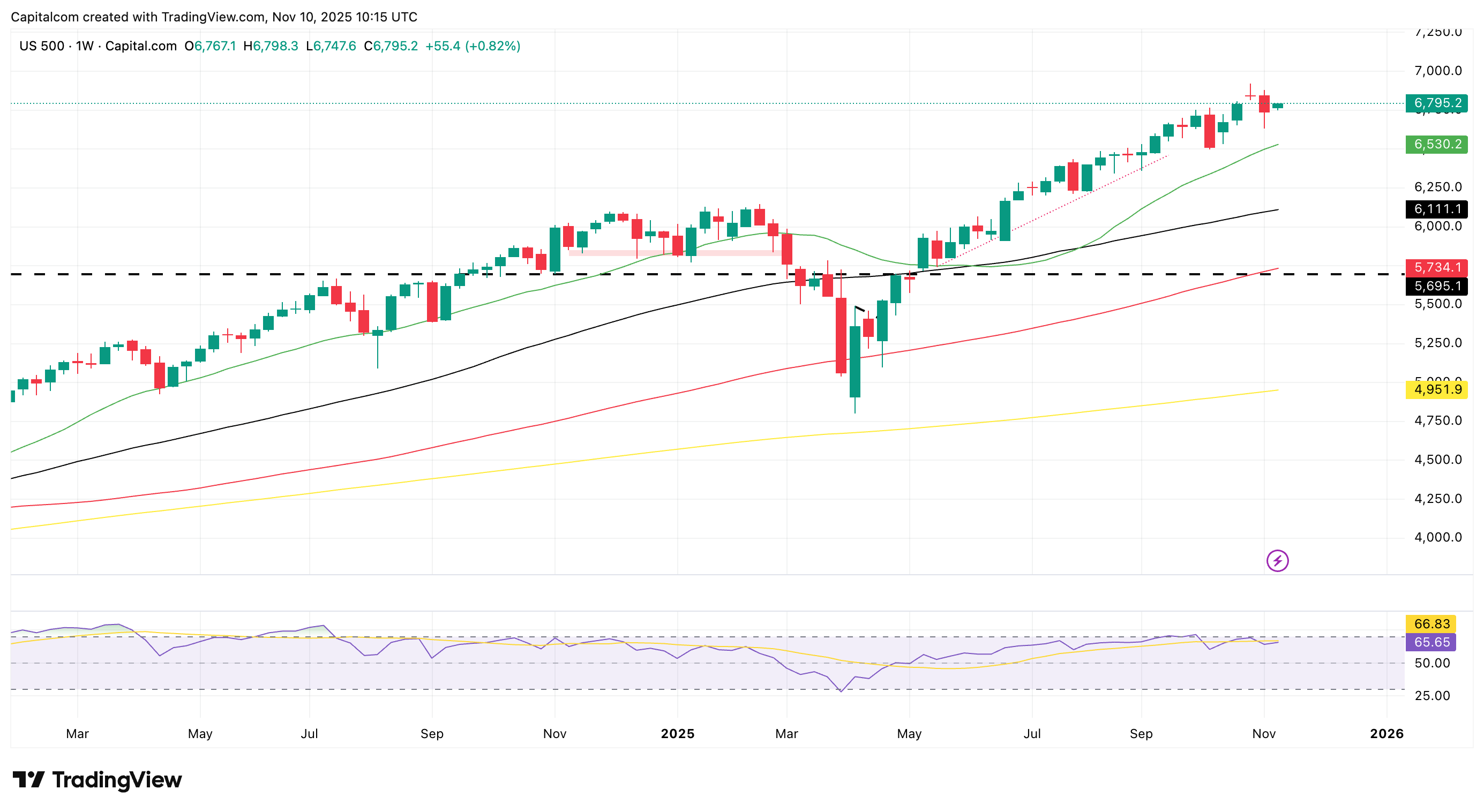Market Mondays: Shutdown relief drives sentiment higher
Market sentiment improves, lifting equities and weighing on the dollar, as a deal aimed at ending the US government shutdown has passed the Senate
It was another whipsaw week for global markets last week with AI-spending angst, shifting rate expectations, and political risk keeping traders on edge, while fresh signs of progress on the U.S. government shutdown helped sentiment recover into the start of this week.
The shutdown finally matters for markets
For much of its roughly 40-day duration, the U.S. government shutdown felt like background noise compared with earnings and central bank meetings. That changed late last week:
- Confidence cracked: The University of Michigan survey showed U.S. consumer sentiment lurching toward cycle lows, with respondents citing the shutdown as a drag.
- Relief rally: Hopes for a bipartisan deal—and news that a compromise package cleared the Senate and was heading to the House—sparked a risk-on bounce into Monday’s Asia/Europe sessions.
The price action suggests investors had underpriced the economic and market impact of prolonged government paralysis. A credible path to reopening reduces a key tail risk and can improve near-term equity tone after last week’s slide.
Gold rallies into “good news”
An intriguing twist has emerged, with gold and silver up around 2% and 3%) respectively, even as equities firm. Part of this is likely technical after a multi-week pullback, but there’s a macro story too. Gold’s medium-term drivers—fiscal largesse, monetary policy, geopolitics, U.S. trade stance, and Fed independence—haven’t disappeared; they’ve merely shifted:
- Less dovish Fed: Markets are trimming the depth/timing of U.S. cuts, which would typically be a headwind for bullion.
- Run-it-hot narrative: Big fiscal plans in the U.S., Europe, and Japan—and proposals like tariff-funded household rebates—keep medium-term inflation risk alive. That supports gold even on “risk-on” days.
Bulls vs. bears: two coherent narratives
You can rationalize both directions right now:
- Bull case: U.S. data has been resilient, earnings broadly solid, and “buy-the-dip” remains the path of least resistance. Pullbacks have been shallow and quickly retraced to new highs.
- Bear case: Valuations are stretched, market breadth is narrow (mega-cap AI leaders doing the heavy lifting), consumer sentiment is soft, and any disappointment from the “Magnificent Seven” could have outsized impact.
Technical backdrop: Weekly RSI readings flashed overbought, and a “shooting-star” style candle preceded last week’s sell-off—but Friday’s strong rebound preserved the uptrend of higher highs and higher lows across the S&P 500, Dow, and Nasdaq. So far, it still looks like a garden-variety shakeout.
S&P 500 weekly chart

Past performance is not a reliable indicator of future results.
UK: BoE eases—carefully—into stagflation risks
The Bank of England delivered a dovish hold and guided toward a gradual easing path, with services inflation cooling just enough to allow cautious cuts. Markets now price roughly 60% odds of a 25 bp cut at the 18 December meeting.
This week’s UK data (key for rate path):
- Labour market (Tue): Slight softening expected; wage growth easing (ex-bonus and incl. bonus) and unemployment ticking from 4.8% to 4.9% would validate BoE’s easing bias.
- GDP (Thu): Q3 growth seen slowing to 0.2% q/q; September monthly GDP near 0.0%. A weak growth/firm wages combo would revive stagflation worries and complicate the BoE’s path to easing rates.
Australia: RBA all-in on inflation fight
The RBA held but warned it’s laser-focused on returning inflation to the 2–3% band through 2026, even as growth cools and unemployment has drifted higher:
- Jobs (Thu): Consensus is ~+20k employment with unemployment dipping to 4.4% (likely helped by a lower participation rate). A softer labour print could pressure AUD and add ASX volatility; a firmer print may buy the RBA time—without guaranteeing earlier cuts.
US dollar and Oil
The DXY bounced off a double bottom toward the psychologically important 100 level, then stalled. With shutdown risks fading, the early-week tone is slightly dollar-soft, aiding EUR/USD, GBP/USD, gold, and silver. Bigger picture, if the Fed leans more hawkish than peers into 2026 while the U.S. economy outperforms, the dollar could resume a slow bottoming into recovery path, pressuring EUR and GBP into next year. USD/JPY remains a function of BoJ’s gradualism plus expansive Japanese fiscal policy.
Crude lifted modestly from last week’s lows after OPEC signalled it will ease off 2026 supply hikes even as November output inches higher. Near term, the low-$60s look like a policy-tolerated sweet spot; rallies toward $62–63 risk pullbacks if producers jawbone supply to defend market share and demand signals stay mixed.